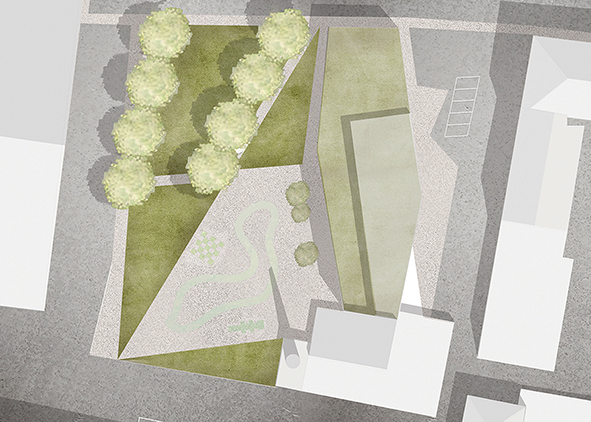Rigenerazione urbana. Benefici delle nature-based solutions
DOI:
https://doi.org/10.19229/2464-9309/9162021Parole chiave:
nature-based solutions, rigenerazione urbana, benessere, isola di calore, resilienzaAbstract
L’ambiente urbano è oggi caratterizzato da numerose criticità legate alla cementificazione: tra le principali, il fenomeno isola di calore, causa di diverse problematiche legate alla salute dei cittadini, soprattutto per le fasce di popolazione più deboli come bambini e anziani. Il contributo espone gli esiti di una ricerca finalizzata a individuare una combinazione di nature-based solutions che offra buoni benefici sia dal punto di vista del miglioramento del comfort microclimatico sia dal punto di vista del comfort psicologico per i soggetti destinati a fruire delle aree rigenerate.
Downloads
##plugins.generic.articleMetricsGraph.articlePageHeading##
Riferimenti bibliografici
Abdi, B., Hami, A. and Zarehaghi, D. (2020), “Impact of small-scale tree planting patterns on outdoor cooling and thermal comfort”, in Sustainable Cities and Society, vol. 56, 102085, pp. 1-12. [Online] Available at: doi.org/10.1016/j.scs.2020.102085 [Accessed 23 April 2021].
Beatley, T. (2011), Biophilic Cities, Integrating Nature into Urban Design and Planning, Island Press, Washington.
De Capua, A. and Errante, L. (2019), “Interpretare lo spazio pubblico come medium dell’abitare urbano | Interpreting public space as a medium for urban liveability”, in Agathón | International Journal of Architecture, Art and Design, vol. 6, pp. 148-161. [Online] Available at: doi.org/10.19229/2464-9309/6142019 [Accessed 23 March 2021].
EEA – European Environment Agency (2019), The European Environment – State and outlook 2020 – Knowledge for transition to a sustainable Europe, Publications Office of the European Union, Luxembourg. [Online] Available at: eea.europa.eu/publications/soer-2020 [Accessed 17 April 2021].
Morabito, M., Crisci, A., Gioli, B., Gualtieri, G., Toscano, P., Di Stefano, V., Orlandini, S. and Gensini, G. F. (2015), “Urban-hazard risk analysis – Mapping of heat-related risks in the elderly in major Italian cities”, in PLoS one, vol. 10, issue 5, e0127277, pp. 1-18. [Online] Available at: doi.org/10.1371/journal.pone.0127277 [Accessed 15 March 2021].
Neonato, F., Tomasinelli, F. and Colaninno, B. (2019), Oro Verde – Quanto vale la natura in città, Il Verde Editoriale Milano.
Palla, A. and Gnecco, I. (2018), “Green Roofs to Improve Water Management”, in Pèrez, G. and Perini, K. (eds), Nature Based Strategies for Urban and Building Sustainability, Butterworth-Heinemann, pp. 203-213. [Online] Available at: doi.org/10.1016/B978-0-12-812150-4.00019-7 [Accessed 15 April 2021].
Pérez, G. and Perini, K. (eds) (2018), Nature based strategies for urban and building sustainability, Butterworth-Heinemann. [Online] Available at: doi.org/10.1016/C2016-0-03181-9 [Accessed 25 March 2021].
Perini, K. (2013), Progettare il verde in città – Una strategia per l’architettura sostenibile, FrancoAngeli, Milano.
Polo-Labarrios, M. A., Quezada-García, S., Sánchez-Mora, H., Escobedo-Izquierdo, M. A. and Espinosa-Paredes, G. (2020), “Comparison of thermal performance between green roofs and conventional roofs”, in Case Studies in Thermal Engineering, vol. 21, 100697. [Online] Available at: doi.org/10.1016/j.csite.2020.100697 [Accessed 25 March 2021].
Scudo, G. and Ochoa De La Torre, J. M. (2003), Spazi verdi urbani – La vegetazione come strumento di progetto per il comfort ambientale negli spazi abitati, Esselibri-Simone, Napoli.
Taha, H. (1997), “Urban climates and heat islands – Albedo, evapotranspiration, and anthropogenic heat”, in Energy and Buildings, vol. 25, issue 2, pp. 99-103. [Online] Available at: doi.org/10.1016/S0378-7788(96)00999-1 [Accessed 23 April 2021].
Thomsit-Ireland, F., Essah, E. A., Hadley, P. and Blanuša, T. (2020), “The impact of green facades and vegetative cover on the temperature and relative humidity within model buildings”, in Building and Environment, vol. 181, 107009. [Online] Available at: doi.org/10.1016/j.buildenv.2020.107009 [Accessed 23 March 2021].
Williams, F. (2017), The nature fix – Why Nature Makes us Happier, Healthier, and more Creative, W. W. Norton & Company, New York.
Yin, J., Yuan, J., Arfaei, N., Catalano, P. J., Allen, J. G. and Spengler, J. D. (2020), “Effects of biophilic indoor environment on stress and anxiety recovery – A between-subjects experiment in virtual reality” in Environment International, vol. 136, article 105427, pp. 1-10. [Online] Available at: doi.org/10.1016/j.envint.2019.105427 [Accessed 14 April 2021].

##submission.downloads##
Pubblicato
Come citare
Fascicolo
Sezione
Licenza
AGATHÓN è pubblicata sotto la licenza Creative Commons Attribution License 4.0 (CC-BY).
License scheme | Legal code
Questa licenza consente a chiunque di:
Condividere: riprodurre, distribuire, comunicare al pubblico, esporre in pubblico, rappresentare, eseguire e recitare questo materiale con qualsiasi mezzo e formato.
Modificare: remixare, trasformare il materiale e basarti su di esso per le tue opere per qualsiasi fine, anche commerciale.
Alle seguenti condizioni
Attribuzione: si deve riconoscere una menzione di paternità adeguata, fornire un link alla licenza e indicare se sono state effettuate delle modifiche; si può fare ciò in qualsiasi maniera ragionevole possibile, ma non con modalità tali da suggerire che il licenziante avalli l'utilizzatore o l'utilizzo del suo materiale.
Divieto di restrizioni aggiuntive: non si possono applicare termini legali o misure tecnologiche che impongano ad altri soggetti dei vincoli giuridici su quanto la licenza consente di fare.
Note
Non si è tenuti a rispettare i termini della licenza per quelle componenti del materiale che siano in pubblico dominio o nei casi in cui il nuovo utilizzo sia consentito da una eccezione o limitazione prevista dalla legge.
Non sono fornite garanzie. La licenza può non conferire tutte le autorizzazioni necessarie per l'utilizzo che ci si prefigge. Ad esempio, diritti di terzi come i diritti all'immagine, alla riservatezza e i diritti morali potrebbero restringere gli usi del materiale.


















































































